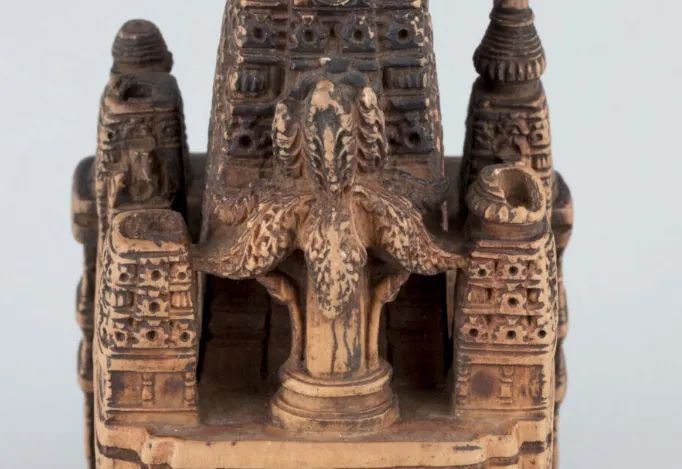
Beside the Bodhi tree, the Vajrasana ▎ Key Moments about the Himalayas (Nine)

11th century, 49 cm tall, kept in the Potala Palace


"Buddhist Seals: The Buddha's Enlightenment and Buddhist Verses"
Discovered in the mid-11th century at the Mahabodhi Temple in Bodh Gaya
Currently housed at the Cleveland Museum of Art
Features the "Five Marks Conjoined" style representing the Buddha's enlightenment
Temple - Sacred Tree - Throne - Buddha - Verse
*Please note the differences between early Buddhist seals and talismans (origins and functions)
ཏཱ་ར་བི་ཧཱ་ར་སྒྲོལ་མའི་ལྷ་ཁང་ངོ།
such as the Bodhi tree and the Buddha statue in the Mahabodhi Temple
the inner sanctum of the temple built by King Asoka
a larger Buddha tooth relic
the original throne of the Buddha statue in the Jokhang Temple in Tibet
the footprint of the Buddha on a stone
a stone fence built under the supervision of the wise scholar Nagarjuna
and the temple of the goddess Tara known as "Dolobihar" and so on
Excerpt from the "Biography of Translator Changyud"
Translator Changyud stayed in the holy site of Vajrasana for more than three months
(1197-1264)
* The translator's description of the inner chambers of the temple and the stone enclosure is not accurate.

Note: The dating of this artifact may be later than the 11th century.

The architectural complex of Mahabodhi Temple in Bodh Gaya, where the Buddha attained enlightenment, continues to be a significant pilgrimage site for Buddhists. Even today, we can find numerous pilgrimage marks related to this sacred place in major Tibetan monasteries, in the form of architectural models of Mahabodhi Temple. Whether brought by ancient pilgrims or replicated in various monasteries, these models represent a familial lineage with the Mahabodhi Temple. They carry the spiritual power and symbolic significance of the temple. Over the course of history, the concept of building models has evolved beyond merely replicating the glory of the sacred site. Different regions have used architecture as a medium to depict the life and teachings of the Buddha. During the colonial era in South Asia and subsequent battles for control over temple management (between Buddhist revivalist organizations and pan-Indian Hinduism), these preserved architectural models have become valuable research material for archaeologists and sacred objects for modern-day Buddhists. The architecture captures great moments, while the models help to preserve and commemorate these moments.
By the late 15th century, the Mahabodhi Temple in Bodh Gaya had lost its former glory, with foreign armies and non-Buddhist religious sects vying for control of the sacred site. The three centuries from the 11th to the 13th centuries are often seen as the golden age of the Mahabodhi Temple, and scholars from Tibet seized the opportunity to visit during this final era. Tibetan scholars such as the guru of the first Karmapa, Gampopa (1105-1198), the teacher of the Sakya founder, Sachen Kunga Nyingpo (11th century), and the translator of the Kagyu school, Lotsawa Marpa Lotsawa (1059-1109) all made pilgrimages to the sacred site, while the translator Chakya Sherab Gyaltsen left precious records about the Mahabodhi Temple. The people of Tibet referred to the Mahabodhi Temple in Bodh Gaya as the Diamond Throne (Vajrasana), the holy site where the Buddha attained enlightenment, embodying the supreme qualities of the protector of the Diamond Throne, the monastic and lay community, and the sacred teachings. Additionally, numerous architectural models of the site from the same period have been found, leading to the construction of local temples resembling the sacred site.



"Imitation of the architectural genealogy of the Mahabodhi Temple",by author



"Beijing Zhenjue Temple (Five Pagoda Temple)" - Photographer unknown
There is much controversy surrounding the architectural models of the Mahabodhi Temple in Bodh Gaya, with some scholars arguing that such models should be considered as independent objects of study. There are two main reasons for this: firstly, most existing models are not purely representational, and secondly, classical craftsmen during the ancient times carried out elaborate adaptations in terms of composition and details. However, the idea of treating models as independent objects of study does not seem to contradict the inherent notion that models faithfully depict the architecture. For Buddhists, the Mahabodhi Temple complex (including the Bodhi tree, the diamond throne where Buddha achieved enlightenment, and numerous monk dwellings and temple ruins) is a complete pilgrimage site, and the superimposition of structures on models is simply to present the completeness of the sacred site's holy concept. In the numerous surviving architectural models today, artistic expressions that transcend form are abundant. To highlight the connection between the sacred site and Buddha's life story, people choose to depict important moments in Buddha's life on the four gateways. To indicate the multiple remnants of the sacred site, people choose to gather scattered religious landmarks in one place. To clarify the esoteric and exoteric nature of Buddha's teachings, people choose to carve five Buddhas and inherent characters from numerous Buddhist stories on the models.
Born in Sri Lanka, Anagarika Dharmapala (1864-1933), a modern Buddhist revivalist and founder of the Maha Bodhi Society, once stated, "The Mahabodhi Temple is the unique seal of the Buddha, the supreme altar city where the secret wisdom is preserved." For Buddhists living in different regions, models of the Mahabodhi Temple (including replica temples) serve as religious artifacts used to "recirculate the teachings of the Buddha and the spirit of offering." Similarly, for those studying and passionate about Buddhism and Asian art, such models are excellent examples of the connection between "image and emotion," masterpieces created through the combination of devout faith and extraordinary imagination. Even though separated by thousands of miles, these models always have the power to transport people to that flower-strewn "indestructible place."



From the first half of the 16th century, from a private collection
Bring the holy landscapes to the snowy land.

